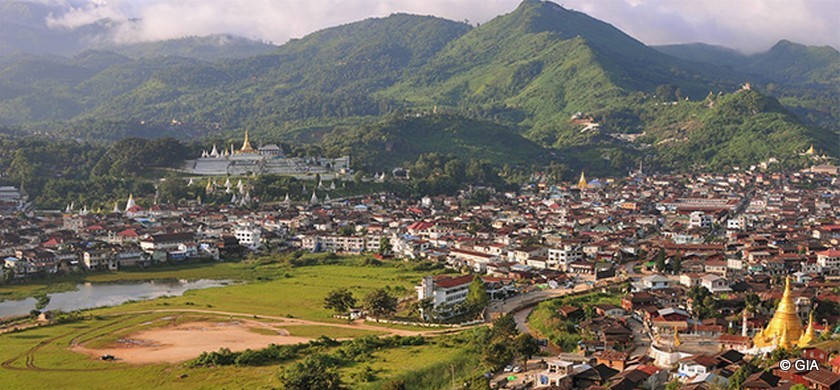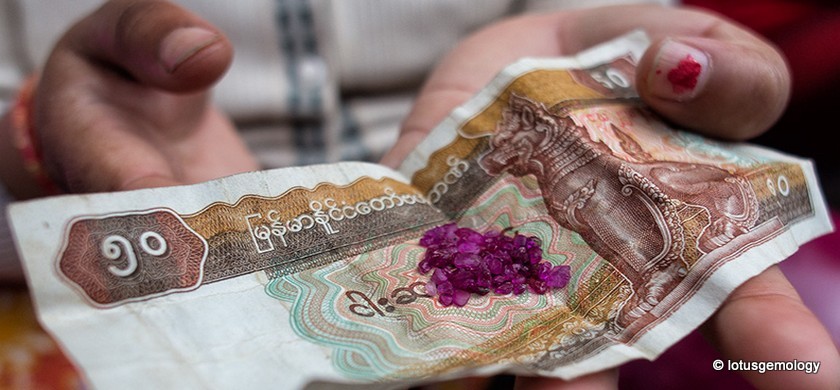Mogok
Known as the Valley of Rubies, Mogok is located 200
kilometres north of Mandalay, nestled in a valley between a number of
large mountains where, due to its altitude (1170 metres), a cool temperate climate can found all year round. The area that is said to be home to 90% of the world’s high-grade rubies.
Mogok has been famous for centuries for its gemstones (including pigeon’s blood rubies and blue sapphires that have been cited in ancient Burmese literature), as well as a dazzling array of semi-precious stones including lapis lazuli, garnet, moonstone, amethyst, peridot and chrysoberyl. Rare stones such as painite, hibbonite, and poudretteite are found only in Mogok and a few other gem localities.
Like many other traditions preserved in Myanmar, mining in Mogok today involves little to no mechanisation and is based on intensive use of manual labour, concentrated on hillside deposits, through open trenches, deep pits, or through excavating tunnels directly into the limestone. A number of bustling ruby markets, including Panchan and Aungchanthar markets, can be found in the centre of town (note that gems sold in markets in Mogok can only be purchased at government licensed dealers).
We can arrange tours of Mogok and its mines (including permits); fill out this form or email info@go-myanmar.com to find out more. Please note that it is not currently possible for foreigners to visit Mogok; we will update this page as soon as the situation changes.
Located in Mandalay Division and bordering Shan State, the Mogok area hosts a diverse ethnic population, including Bamar, Shan, Lisu, Palaung, and Karen ethnic groups, as well as Chinese, Indians and Gurkhas (descendants of a Nepalese group).
As spectacular as the gemstones of Mogok are the town’s lake and the pagoda-covered mountains surrounding the city. The golden stupas of Phaung Daw Oo and Paw Daw Mu pagodas, associated with the famous monk known as Mogok Sayadaw, can be found strewn atop sharp inclines on Daw Nan Kyi mountain. The tranquil Mogok Lake can be found adjacent to the city, and there is also a little-known World War II veteran cemetery that is located just outside of town.
Mogok has been famous for centuries for its gemstones (including pigeon’s blood rubies and blue sapphires that have been cited in ancient Burmese literature), as well as a dazzling array of semi-precious stones including lapis lazuli, garnet, moonstone, amethyst, peridot and chrysoberyl. Rare stones such as painite, hibbonite, and poudretteite are found only in Mogok and a few other gem localities.
Like many other traditions preserved in Myanmar, mining in Mogok today involves little to no mechanisation and is based on intensive use of manual labour, concentrated on hillside deposits, through open trenches, deep pits, or through excavating tunnels directly into the limestone. A number of bustling ruby markets, including Panchan and Aungchanthar markets, can be found in the centre of town (note that gems sold in markets in Mogok can only be purchased at government licensed dealers).
We can arrange tours of Mogok and its mines (including permits); fill out this form or email info@go-myanmar.com to find out more. Please note that it is not currently possible for foreigners to visit Mogok; we will update this page as soon as the situation changes.
Located in Mandalay Division and bordering Shan State, the Mogok area hosts a diverse ethnic population, including Bamar, Shan, Lisu, Palaung, and Karen ethnic groups, as well as Chinese, Indians and Gurkhas (descendants of a Nepalese group).
As spectacular as the gemstones of Mogok are the town’s lake and the pagoda-covered mountains surrounding the city. The golden stupas of Phaung Daw Oo and Paw Daw Mu pagodas, associated with the famous monk known as Mogok Sayadaw, can be found strewn atop sharp inclines on Daw Nan Kyi mountain. The tranquil Mogok Lake can be found adjacent to the city, and there is also a little-known World War II veteran cemetery that is located just outside of town.

